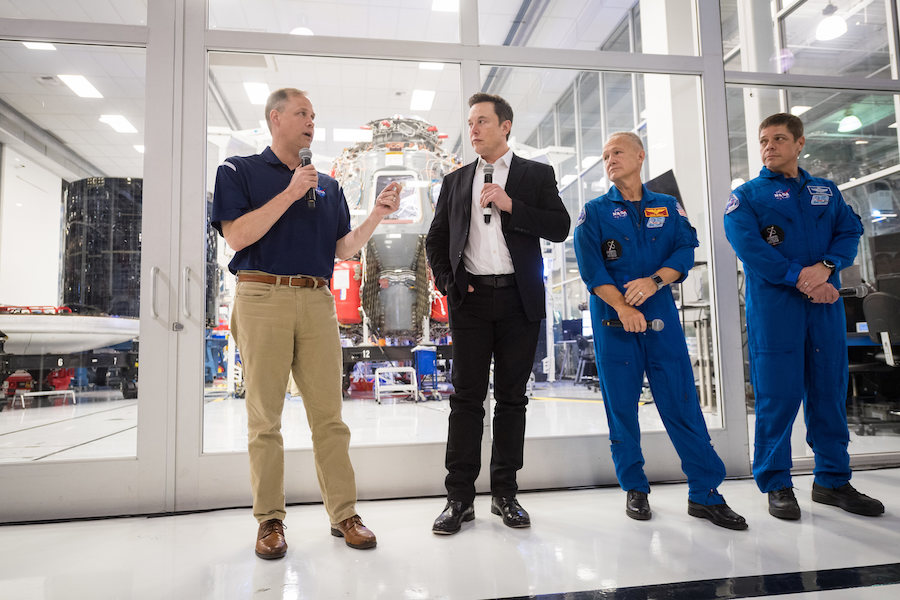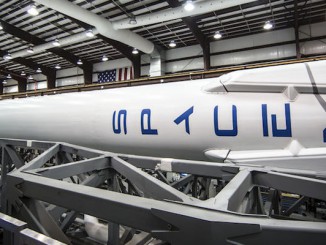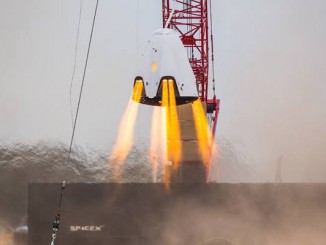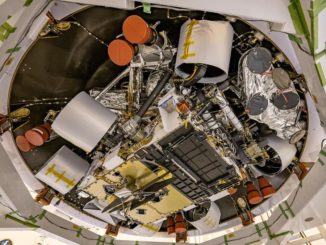
NASA Administrator Jim Bridenstine said this week the space agency is not unduly delaying the debut of new SpaceX and Boeing commercial crew capsules as engineers gear up for a challenging rapid-fire sequence of test flights in the next few months, all against the backdrop of in-depth safety reviews before clearing the privately-owned ships to carry astronauts.
In an interview Thursday with Spaceflight Now, Bridenstine said SpaceX and Boeing are “decently set up for success” as the companies head into the high-profile test campaign. He said he expects at least one of the companies to launch astronauts “in the first quarter, (or) maybe the first half of next year.”
Both contractors are delivering detailed data books to NASA for review, part of the process to ensure the capsules meet the space agency’s performance and safety requirements. Bridenstine called the schedule “aggressive” and said it would be “incorrect” for anyone to conclude NASA’s reviews are responsible for delays in the commercial crew program.
“Contractor performance is important, and NASA is important as well,” Bridenstine told Spaceflight Now in an interview Thursday. “Without NASA, none of these contractors would be where they are now. None of them. Our NASA engineers, our NASA technologists, are embedded working side-by-side with them, taking decades of history and applying our knowledge to their commercial capabilities.
“No, it is absolutely untrue that NASA is slowing it down,” Bridenstine said. “NASA is making sure that it gets done right.”
Officials from NASA, industry and advisory boards have previously identified the importance of setting clear NASA requirements, coupled with smoother communication between NASA and contractors, as a key learning lesson from the commercial crew program as the space agency sets its sights on an accelerated program to return astronauts to the moon by 2024.
“It is an aggressive schedule,” Bridenstine said, referring to the commercial crew program. “It is in the realm of what is possible, but we’re not going to take any risk on our astronauts that we don’t have to.”
Spaceflight Now members can read a transcript of our full interview with Jim Bridenstine. Become a member today and support our coverage.
The first major test in the lead-up to a crew flight by SpaceX is a hotfire test of the Crew Dragon’s SuperDraco abort engines at Cape Canaveral. CNBC reported Thursday that the test is scheduled for Nov. 2.
It’s a redo of an attempted SuperDraco static fire test in April, which ended in an explosion that destroyed the Crew Dragon test vehicle, the same craft that completed a successful unpiloted test flight to the International Space Station in March.
After finding the likely cause of the explosion and implementing corrective actions — SpaceX found fault in a propulsion system valve — engineers are gearing up to repeat the ground abort engine test.
SpaceX tweeted a video Thursday of a modified SuperDraco abort engine performing a test-firing.
Test of Crew Dragon’s upgraded launch escape system ahead of static fire and in-flight abort tests – altogether we are conducting hundreds of tests to verify the system’s advanced capabilities to carry astronauts to safety in the unlikely event of an emergency pic.twitter.com/a4FucMh85l
— SpaceX (@SpaceX) October 24, 2019
“For SpaceX, we have a static fire test, and the last time they did a static fire, the capsule blew up,” Bridenstine said. “I’m not saying that’s going to happen again. But we are going to, once again, learn from the static fire. We need to make sure that during that static fire, all of their margins are being met for factors of safety. Even if it doesn’t blow up, we need to go through and analyze all the data.
Assuming the static fire test goes well, the same Crew Dragon vehicle used for the SuperDraco static fire is scheduled to launch around six weeks later — in mid-December — on top of a modified Falcon 9 rocket from pad 39A at NASA’s Kennedy Space Center in Florida. About a minute to a minute-and-a-half later, the Crew Dragon will fire its SuperDraco engines to swiftly propel itself off the top of the Falcon 9, simulating an escape maneuver during a launch accident.
Eight SuperDraco rocket engines mounted in pods around the circumference of the Crew Dragon are programmed to quickly fire if computers detect an emergency during launch. NASA and SpaceX want to ensure the escape system is up to the job before putting astronauts on the spacecraft.
“After (the static fire test), we have a high-altitude abort test that has to be done,” Bridenstine said. “Again, we have to analyze all of that data to make sure all of the margins are being met. Again, our number one goal is the safety of our astronauts.
“While that’s underway, they’re also doing iterative drop tests of the Mk. 3 parachute (on Crew Dragon).” Bridenstine said. “We need to see success. The key there is consistent, repeatable performance. And on each of those drop tests, the safety margins need to be met — the safety margins that we agreed to years ago now — so there’s a lot that goes into that.”
Boeing plans a pad abort test of the Starliner spacecraft as soon as Nov. 4, followed by an unpiloted Starliner flight to the space station set for liftoff from Cape Canaveral as soon as Dec. 17 aboard a United Launch Alliance Atlas 5 rocket.
Like SpaceX, Boeing has run into trouble with its crew capsule abort system. Faulty valves lead to a propellant leak on a test stand during a test-firing of the Starliner spacecraft’s abort engines last year.
“On the Boeing side, they also have a pad abort test upcoming, and they have parachute challenges and tests that are underway,” Bridenstine said. “Again, all of their data needs to be reviewed and analyzed by NASA to make sure that they’re meeting their margins.”
NASA has lacked an indigenous capability to launch astronauts to the space station since the retirement of the space shuttle 2011. Since then, NASA has relied on Russian Soyuz vehicles to ferry crews to and from the orbiting research laboratory.
When the space shuttle retired, NASA said commercial crew capsules could be carrying astronauts to orbit by 2015, but Congress did not appropriate NASA’s requested funding for the program for several years, triggering a delay in the first human flight from 2015 to 2017.
NASA awarded Boeing and SpaceX contracts worth up to $4.2 billion and $2.6 billion, respectively, in 2014 to proceed into full development of the Starliner and Crew Dragon spacecraft. Since Congress began fully funding the commercial crew program, launches of the crew capsules with people have been delayed from 2017 to 2020.
Bridenstine said Thursday that NASA will likely purchase additional Soyuz seats from Russia, which cost more than $80 million in NASA’s most recent Soyuz seat buy, to provide some breathing room in the commercial crew schedule. The last Soyuz seat currently under NASA’s control launches in April 2020, and the crew member occupying that seat is scheduled to return to Earth next October.
Email the author.
Follow Stephen Clark on Twitter: @StephenClark1.



